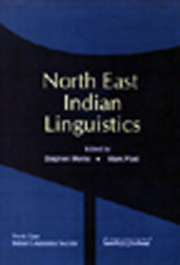Book contents
- Frontmatter
- Contents
- Introduction
- Foreword
- Phonology
- Lexicon
- 5 Lexicon in a Contact Language: The Case of Bishnupriya
- 6 Shafer's ‘parallels’ between Khasi and Sino-Tibetan
- 7 An Exploratory Study of the Terms of Relationship in Khamti of Lohit district in Arunachal Pradesh
- 8 Verbs of Position, Existence, Location and Possession and their Grammaticalization Pathways in the Tani Languages
- Morphology, Syntax, and Semantics
- Language Description and Language Endangerment
6 - Shafer's ‘parallels’ between Khasi and Sino-Tibetan
from Lexicon
Published online by Cambridge University Press: 26 October 2011
- Frontmatter
- Contents
- Introduction
- Foreword
- Phonology
- Lexicon
- 5 Lexicon in a Contact Language: The Case of Bishnupriya
- 6 Shafer's ‘parallels’ between Khasi and Sino-Tibetan
- 7 An Exploratory Study of the Terms of Relationship in Khamti of Lohit district in Arunachal Pradesh
- 8 Verbs of Position, Existence, Location and Possession and their Grammaticalization Pathways in the Tani Languages
- Morphology, Syntax, and Semantics
- Language Description and Language Endangerment
Summary
Introduction
In 1904, Wilhelm Schmidt gave comparative evidence in order to establish the notion that Khasi was a member of the Austroasiatic family. In support of this, he proposed many etymologies linking Khasi to the Palaungic languages, Khasi's nearest neighbours to the East (Schmidt 1904).
Over a century has now passed, and with the better knowledge of Austroasiatic which we have today, we can see that Schmidt's findings were fundamentally correct. We notice that a few of his etymologies require corrections, or in some cases rejection for specific reasons; but, more importantly, we now have numerous new etymologies, inaccessible to him at the time, which support his general claim. For example, a rapid look at a reconstructed vocabulary of the Waic languages (Diffloth 1980) will make the point clear (Waic being a sub-branch of Palaungic).
This being the case, several other questions present themselves. Geographically, Khasi is a linguistic island surrounded today on all sides by Tibeto-Burman and Indo-Aryan languages. Its Palaungic relatives are about five hundred kilometers away as the crow flies. Moreover, the high mountain chains and deep gorges that stand in the way in Northern Burma are oriented for the most part in a North-South direction, making East-West travel between the Palaungic and the Khasian regions even more difficult than the distance indicates. How then did the languages come to be where they now are? Languages evidently have been spreading one way or another, but which ones, by which ways, and in what times?
Half a century after Schmidt, Robert Shafer wrote an article concerning these unanswered questions (Shafer 1952).
- Type
- Chapter
- Information
- North East Indian Linguistics , pp. 93 - 104Publisher: Foundation BooksPrint publication year: 2008



